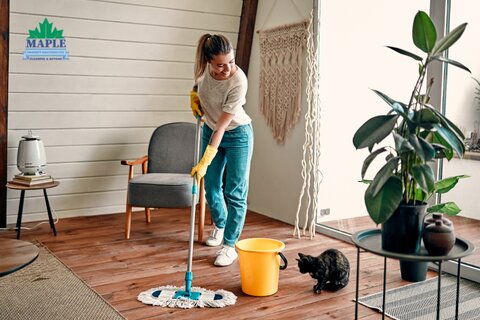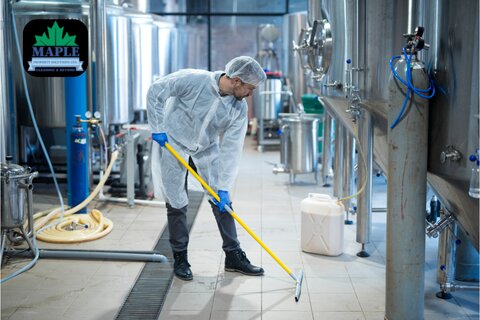Starting a cleaning service can be a profitable venture. It’s a business with low startup costs and high demand.
Many people seek reliable help to keep their homes and offices clean. If you have an eye for detail and a knack for cleanliness, this could be the perfect business for you. In this guide, we will explore the steps to start your own cleaning service.
You’ll learn about the necessary tools, how to find clients, and tips for running a successful business. Whether you aim to go solo or build a team, this information will help you get started. Ready to dive in? Let’s unlock the secrets to launching your cleaning service today!

Business Basics
Starting a cleaning service can be a lucrative business idea. It has a low initial cost and high demand. To succeed, you need to understand some business basics. This includes knowing the essential requirements and legal considerations. Let’s dive into these aspects to get you started on the right foot.
Essential Requirements
Before starting your cleaning service, ensure you have all the essentials. These include supplies, equipment, and a business plan.
- Cleaning Supplies: Invest in high-quality cleaning products. This includes detergents, disinfectants, and glass cleaners.
- Equipment: Purchase necessary tools. Examples are vacuum cleaners, mops, brooms, and scrubbers.
- Transportation: Reliable transportation is crucial. You need to move between client locations efficiently.
A detailed business plan is a must. It helps in mapping out your business strategy. Include the following in your plan:
- Target market analysis
- Marketing strategy
- Budget and financial plan
- Pricing strategy
Training is another essential requirement. Ensure you and your team know how to use the cleaning products and equipment. Consider offering specialized cleaning services. Examples include carpet cleaning, window washing, and deep cleaning.
Lastly, invest in branding. Create a logo and business cards. A professional website can attract more customers. An active presence on social media can also help.
Legal Considerations
Legal considerations are crucial for starting a cleaning service. You need to comply with local, state, and federal regulations. Here are some steps to consider:
- Business Structure: Decide on your business structure. Common options are sole proprietorship, partnership, LLC, or corporation.
- Business License: Obtain the necessary business licenses. Check with your local city or county office.
- Insurance: Get insurance for your cleaning business. General liability insurance protects against accidents and damages.
Tax registration is another important step. Register for an Employer Identification Number (EIN) with the IRS. This is necessary for tax purposes.
Also, consider worker’s compensation insurance. It’s required if you have employees. This covers medical expenses and lost wages due to work-related injuries.
Lastly, have contracts in place. Draft clear service agreements for your clients. This outlines the scope of services, pricing, and terms. It helps avoid misunderstandings and legal disputes.
To Get The Best Cleaning Services In Canada – Click Here
Market Research
Starting a cleaning service can be a lucrative business venture. But before diving into the cleaning industry, doing market research is essential. Market research helps you understand the needs of your potential customers and stand out from competitors. This research will guide you in making informed decisions, ensuring your cleaning service meets market demands.
Identifying Target Audience
Knowing who your target audience is will help you tailor your services to meet their needs. Start by identifying the demographics you want to serve. These could include:
- Residential clients: Homeowners or renters who need regular or one-time cleaning services.
- Commercial clients: Offices, retail stores, and other businesses that require consistent cleaning.
- Specialty clients: Medical facilities, schools, or gyms with specific cleaning needs.
To identify your target audience, consider the following steps:
- Conduct surveys to understand the cleaning needs of different groups.
- Analyze local demographics and income levels.
- Check online forums and social media groups for discussions about cleaning services.
Here’s a simple table to help you categorize your potential clients:
| Client Type | Frequency of Service | Specific Needs |
| Residential | Weekly, Bi-weekly, Monthly | General cleaning, deep cleaning, move-in/move-out cleaning |
| Commercial | Daily, Weekly | Office cleaning, restroom sanitation, floor care |
| Specialty | Varies | Sanitization, compliance with health regulations |
Understanding your target audience will help you design marketing strategies and service packages that appeal to them.
Analyzing Competitors
Analyzing competitors is crucial for a successful cleaning service. It helps you understand the market landscape and identify opportunities. Start by identifying your local competitors. Look for:
- Established cleaning companies
- Newer businesses
- Franchise operations
Use the following steps to analyze your competitors:
- Research their services: Visit their websites to see the services they offer. Note the pricing, service packages, and any special offers.
- Check customer reviews: Look at reviews on Google, Yelp, and social media. Pay attention to common complaints and praises.
- Analyze their marketing: Observe their advertising strategies. Note their online presence, such as social media activity and search engine rankings.
Here’s a table to help you compare your competitors:
| Competitor | Services Offered | Price Range | Customer Feedback |
| Company A | General cleaning, deep cleaning | $$ | Positive: Reliable, Negative: High cost |
| Company B | Office cleaning, floor care | $$$ | Positive: Professional, Negative: Scheduling issues |
| Company C | Sanitization, medical facility cleaning | $$ | Positive: Thorough, Negative: Limited services |
This competitor analysis will help you identify gaps in the market. You can then tailor your services to meet unmet needs and differentiate your business.
Service Offerings
Starting a cleaning service is a great way to enter the business world. Offering a variety of cleaning services can attract more clients and meet their specific needs. In this section, we will explore the different types of cleaning services you can offer and how to create custom packages to suit your clients.
Types Of Cleaning Services
There are several types of cleaning services you can provide. Each type caters to different needs and environments. Here are some common options:
- Residential Cleaning: This includes cleaning homes, apartments, and condos. Services may involve dusting, vacuuming, mopping, and bathroom cleaning.
- Commercial Cleaning: Target offices, stores, and other business spaces. Tasks include cleaning floors, windows, and common areas.
- Deep Cleaning: This service goes beyond regular cleaning. It involves thorough cleaning of areas that are often neglected, like baseboards, blinds, and behind appliances.
- Move-In/Move-Out Cleaning: This is ideal for clients moving into a new place or leaving an old one. It ensures the property is spotless for the next occupant.
- Specialty Cleaning: Includes services like carpet cleaning, window washing, and post-construction clean-up.
Offering a variety of cleaning services helps to cover a wide range of client needs. This diversification can attract more customers and increase your revenue.
Custom Packages
Creating custom packages can make your cleaning service more appealing. Packages can be tailored to fit different client needs and budgets. Here are some steps to create effective custom packages:
- Assess Client Needs: Understand what your clients need. Do they require regular cleaning or a one-time deep clean?
- Bundle Services: Combine different services into a single package. For example, a “Spring Cleaning” package might include deep cleaning, window washing, and carpet cleaning.
- Offer Flexible Options: Provide options for frequency, such as weekly, bi-weekly, or monthly services. This flexibility can cater to different client schedules and preferences.
- Set Clear Pricing: Display your prices clearly. Clients appreciate knowing what they will pay upfront. Consider creating a table to show different package options and their costs.
| Package | Includes | Price |
| Basic Cleaning | Dusting, Vacuuming, Mopping | $50 |
| Deep Cleaning | Basic Cleaning + Baseboards, Blinds, Appliances | $100 |
| Move-In/Move-Out | Deep Cleaning + Inside Cabinets, Drawers | $150 |
By offering custom packages, you can meet the specific needs of your clients. This personalized approach can lead to higher customer satisfaction and repeat business.

Pricing Strategies
Starting a cleaning service can be a rewarding business venture. One of the most crucial aspects to consider is your pricing strategy. The right pricing can help you attract and retain clients while ensuring your business remains profitable. In this blog post, we will explore key strategies for setting your cleaning service rates, including cost analysis and setting competitive rates.
Cost Analysis
Before setting your prices, conduct a thorough cost analysis. This step helps you understand your expenses and ensures you cover them while making a profit. Here are the main costs to consider:
- Labor Costs: Wages for your cleaning staff.
- Supplies and Equipment: Cleaning products, vacuums, mops, etc.
- Transportation: Fuel and vehicle maintenance costs.
- Insurance: Liability and worker’s compensation insurance.
- Marketing: Advertising and promotional expenses.
- Administrative Costs: Office supplies, software, and utilities.
To help you visualize your costs, here is a simple table:
| Expense Category | Estimated Monthly Cost |
| Labor | $3,000 |
| Supplies and Equipment | $500 |
| Transportation | $300 |
| Insurance | $200 |
| Marketing | $150 |
| Administrative | $100 |
By understanding these costs, you can set your prices to ensure you cover all expenses and make a profit. This will also help you identify areas where you can reduce costs without compromising quality.
Setting Competitive Rates
Once you have a clear understanding of your costs, the next step is to set competitive rates. Your pricing should reflect the quality of your service while being attractive to potential clients. Consider the following:
- Market Research: Study your competitors’ prices. This gives you an idea of the going rate in your area.
- Service Packages: Offer different packages to cater to various client needs. For example:
- Basic Cleaning: $70
- Deep Cleaning: $120
- Move-out Cleaning: $150
- Hourly vs. Flat Rates: Decide whether to charge by the hour or a flat rate. This depends on the type of service and client preference.
- Discounts and Promotions: Offer discounts for first-time clients or package deals. This can attract new customers and retain existing ones.
Here’s an example of a pricing table for different cleaning services:
| Service | Rate |
| Basic Cleaning | $70 |
| Deep Cleaning | $120 |
| Move-out Cleaning | $150 |
Setting competitive rates involves balancing affordability with quality. Regularly review and adjust your prices based on market changes and client feedback. This will ensure your cleaning service remains attractive and profitable.
Brand Development
Starting a cleaning service is a great business idea. One of the first steps to success is brand development. A strong brand will help your business stand out and attract customers. Two key elements of brand development are choosing a business name and creating a logo. These will be the face of your company and can make a lasting impression.
Choosing A Business Name
Choosing the right business name is crucial. It should be memorable and reflect the services you offer. Here are some tips for picking the perfect name:
- Keep it simple: A short and easy-to-pronounce name is best.
- Reflect your services: Include words related to cleaning.
- Check availability: Make sure the name is not already taken. You can check this online.
- Consider your audience: Choose a name that appeals to your target customers.
- Think about the future: Ensure the name can grow with your business.
Here is a table that summarizes these tips:
| Tip | Description |
| Keep it simple | Short and easy to pronounce |
| Reflect your services | Include cleaning-related words |
| Check availability | Ensure the name is not taken |
| Consider your audience | Appeal to target customers |
| Think about the future | Allow room for business growth |
Take your time and brainstorm different names. Ask friends and family for feedback. A good business name can set you apart from competitors.
Creating A Logo
A logo is a visual representation of your brand. It should be unique and professional. Here are some steps to create an effective logo:
- Research: Look at logos of other cleaning services. Note what you like and dislike.
- Choose a style: Decide on a style that fits your brand. This could be modern, classic, or fun.
- Select colors: Use colors that represent cleanliness and trust. Blue, green, and white are popular choices.
- Pick a font: Use a clean and easy-to-read font.
- Design or hire a designer: You can create a logo yourself using online tools or hire a professional designer.
Here is a table that outlines these steps:
| Step | Description |
| Research | Look at other logos for inspiration |
| Choose a style | Pick a style that fits your brand |
| Select colors | Use colors that represent cleanliness |
| Pick a font | Choose a clean and readable font |
| Design or hire a designer | Create it yourself or hire a professional |
A well-designed logo can help your cleaning service look professional. It will also make your brand more recognizable. Invest time in creating a logo that you are proud of.
Marketing Plan
Starting a cleaning service can be a rewarding business. But to ensure success, you need a strong marketing plan. This plan helps you reach potential customers and grow your business. Let’s explore two key parts of your marketing plan: Online Marketing and Local Advertising.
Online Marketing
Online marketing helps you reach a large audience. Many people search for cleaning services online. So, having a strong online presence is crucial. Here are some steps to improve your online marketing:
- Create a Website: Your website should be easy to navigate. Include information about your services, pricing, and contact details.
- Search Engine Optimization (SEO): Use keywords like “cleaning service,” “home cleaning,” and “office cleaning.” This helps people find your website on search engines.
- Social Media: Use platforms like Facebook, Instagram, and Twitter. Share photos of your work, customer reviews, and special offers.
- Online Reviews: Encourage customers to leave reviews on Google and Yelp. Positive reviews build trust and attract new clients.
- Email Marketing: Collect email addresses from your customers. Send them newsletters with cleaning tips and special promotions.
Here’s a simple table to summarize these steps:
| Step | Action |
| Create a Website | Design a user-friendly site with service details |
| SEO | Use relevant keywords to improve search engine ranking |
| Social Media | Engage with customers on Facebook, Instagram, and Twitter |
| Online Reviews | Encourage reviews on Google and Yelp |
| Email Marketing | Send newsletters and promotions to customers |

Local Advertising
Local advertising helps you connect with people in your community. Here are some effective ways to advertise locally:
- Flyers and Brochures: Distribute them in local neighborhoods. Include your services, contact info, and special offers.
- Local Newspapers: Place ads in community newspapers. Many people still read them.
- Community Boards: Post your flyers on bulletin boards in grocery stores, libraries, and community centers.
- Networking Events: Attend local business events. Meet potential clients and other business owners.
- Car Wraps: Use your vehicle as a moving advertisement. A well-designed car wrap can grab attention.
Consider this table to understand these strategies:
| Method | Action |
| Flyers and Brochures | Distribute in local areas with service details |
| Local Newspapers | Place ads with contact info and offers |
| Community Boards | Post flyers in public places |
| Networking Events | Attend events to meet potential clients |
| Car Wraps | Use branded car wraps for visibility |
Building A Team
Starting a cleaning service involves more than just having the right tools and techniques. Building a strong team is key to success. A team of dedicated and skilled employees ensures quality service and customer satisfaction. Here’s how to build an effective team for your cleaning service.
Hiring Employees
Hiring the right employees is crucial. Look for individuals who are reliable, detail-oriented, and have a good work ethic. Begin by creating a clear and detailed job description. Include the roles, responsibilities, and qualifications required.
Advertise the job openings on various platforms. Use online job boards, local newspapers, and community bulletin boards. Consider offering referral bonuses to current employees for recommending potential hires.
During the interview process, ask questions that help you understand the candidate’s experience and attitude towards cleaning. Some useful questions include:
- Can you describe your previous cleaning experience?
- How do you handle difficult cleaning tasks?
- What do you think is the most important aspect of cleaning?
After selecting candidates, conduct background checks. This ensures the safety and reliability of your team. Additionally, check their references to verify their work history and performance.
| Step | Description |
| 1. Create Job Description | List roles, responsibilities, and qualifications. |
| 2. Advertise Job Openings | Use online job boards, newspapers, and referrals. |
| 3. Conduct Interviews | Ask about experience, problem-solving, and importance of cleaning. |
| 4. Background Checks | Verify safety and reliability of candidates. |
Training Procedures
Once you have hired your team, the next step is training. Proper training ensures that your employees know the standards and methods of your cleaning service. Begin with an orientation session. Introduce your company’s values, policies, and procedures.
Hands-on training is essential. Demonstrate the correct use of cleaning equipment and products. Show them how to clean different surfaces effectively. Use a checklist to ensure all aspects of training are covered.
Consider pairing new employees with experienced staff members. This allows them to learn on the job and understand the expectations. Monitor their progress and provide feedback regularly.
Conduct regular training sessions to keep your team updated on new cleaning techniques and products. Encourage open communication and address any questions or concerns they may have.
Here’s a basic training plan:
- Orientation: Company values, policies, and procedures.
- Equipment Training: Demonstrate use of cleaning tools.
- Surface Cleaning: Teach techniques for different surfaces.
- On-the-Job Training: Pair with experienced staff.
- Regular Feedback: Monitor progress and provide feedback.
- Ongoing Training: Update on new techniques and products.
Supplies And Equipment
Starting a cleaning service is an excellent business idea. It’s always in demand and can be very profitable. One of the first steps is getting the right supplies and equipment. Having the right tools makes the job easier and more efficient. It also ensures that you can tackle a wide range of cleaning tasks. In this section, we’ll discuss the necessary tools and how to source your supplies.
Necessary Tools
To start a cleaning service, you’ll need several basic tools. These tools help you clean various surfaces and areas effectively. Here are the essentials:
- Vacuum Cleaner: A high-quality vacuum cleaner is crucial. Choose one that works well on both carpets and hard floors.
- Mop and Bucket: A sturdy mop and bucket are necessary for cleaning floors. Look for one with a wringer to make the job easier.
- Cleaning Cloths: Microfiber cloths are great for dusting and wiping surfaces. They are reusable and very effective.
- Scrub Brushes: Different sizes of scrub brushes help tackle tough stains and grime.
- Spray Bottles: These are useful for applying cleaning solutions. Label each bottle for easy identification.
- Protective Gear: Gloves, masks, and safety glasses protect you from chemicals and dirt.
In addition to these basics, you may need more specialized tools. For example, a carpet cleaner for deep-cleaning carpets or a window squeegee for streak-free windows. It’s important to invest in quality tools. They last longer and perform better, saving you money in the long run.
Sourcing Supplies
Finding the right supplies is as important as having the right tools. You need effective and safe cleaning products. Here are some tips for sourcing your supplies:
- Wholesale Stores: These stores offer bulk products at a lower cost. Examples include Costco and Sam’s Club.
- Online Retailers: Websites like Amazon and eBay have a wide range of cleaning supplies. You can compare prices and read reviews before purchasing.
- Local Suppliers: Local stores can be a good source for immediate needs. They often offer discounts for bulk purchases.
- Manufacturer Direct: Some cleaning product manufacturers sell directly to businesses. This can save you money and ensure a steady supply.
When choosing cleaning products, look for eco-friendly options. These are safer for the environment and for your clients. Always read labels to ensure the products are suitable for the surfaces you will be cleaning.
Here is a table to help you compare different sources:
| Source | Advantages | Disadvantages |
| Wholesale Stores | Lower cost, bulk purchasing | Requires membership, limited selection |
| Online Retailers | Wide range, convenience | Shipping costs, longer wait times |
| Local Suppliers | Immediate availability, support local business | Higher prices, limited bulk options |
| Manufacturer Direct | Lower cost, reliable supply | Requires bulk orders, limited products |
By carefully selecting your supplies, you can ensure quality service and customer satisfaction. Always keep an eye out for sales and discounts to reduce costs further. Happy cleaning!
Customer Service
Starting a cleaning service requires attention to many details, but one of the most important is customer service. Excellent customer service can set your business apart from others. It helps in building trust and loyalty, which leads to repeat clients and referrals. Let’s explore some key aspects of customer service for your cleaning business.
Client Communication
Effective client communication is the backbone of good customer service. Clear and prompt communication ensures that clients feel valued and understood. Here are some tips:
- Listen Actively: Pay close attention to client needs and preferences. Repeat back what you heard to confirm understanding.
- Be Clear and Concise: Use simple language. Avoid jargon. Ensure your messages are easy to understand.
- Timely Responses: Respond to inquiries and concerns quickly. This shows clients that you respect their time.
- Consistent Updates: Keep clients informed about appointment times, service updates, and any changes. Regular updates build trust.
Here is a table that highlights some key elements of effective client communication:
| Element | Description |
| Listening | Understand client needs and confirm details |
| Clarity | Use simple, clear language |
| Timeliness | Respond promptly to client inquiries |
| Updates | Keep clients informed regularly |
Handling Feedback
Handling feedback effectively is crucial for improving your cleaning service and maintaining client satisfaction. Positive and negative feedback both provide valuable insights. Here’s how to manage it:
- Encourage Feedback: Ask clients for their opinions on your service. Use surveys or follow-up calls to gather feedback.
- Show Appreciation: Thank clients for their feedback, regardless of whether it is positive or negative. Appreciation fosters goodwill.
- Address Issues Promptly: If clients provide negative feedback, address their concerns quickly. Offer solutions or compensations if needed.
- Implement Changes: Use feedback to make improvements. Show clients that their opinions lead to positive changes.
Consider the following steps for handling client feedback:
- Request feedback after each service.
- Thank clients for their input.
- Analyze feedback for common themes.
- Make necessary adjustments to your services.
- Inform clients about changes made based on their feedback.
By focusing on client communication and handling feedback effectively, you can enhance your cleaning service’s reputation and ensure long-term success.

Growth Strategies
Starting a cleaning service can be a profitable venture. But to ensure long-term success, it’s crucial to focus on growth strategies. These strategies will help you expand your business and reach more clients. Let’s explore two effective growth strategies: expanding services and franchising opportunities.
Expanding Services
Expanding your services can attract more clients and increase your revenue. By offering a variety of cleaning services, you cater to different needs. Here are some ways to expand your services:
- Residential Cleaning: Offer regular home cleaning, deep cleaning, and move-in/move-out cleaning.
- Commercial Cleaning: Provide cleaning for offices, retail stores, and other commercial spaces.
- Specialized Cleaning: Include carpet cleaning, window cleaning, and upholstery cleaning.
- Post-Construction Cleaning: Clean up after construction or renovation projects.
Expanding services also involves offering additional options like:
- Eco-Friendly Cleaning: Use green products to attract environmentally conscious clients.
- Customized Cleaning Plans: Tailor services to meet specific client needs and preferences.
- Seasonal Cleaning: Offer spring cleaning, holiday cleaning, and other seasonal services.
Consider using a table to organize your service offerings:
| Service Type | Description |
| Residential Cleaning | Regular, deep, and move-in/move-out cleaning |
| Commercial Cleaning | Office, retail, and commercial space cleaning |
| Specialized Cleaning | Carpet, window, and upholstery cleaning |
| Post-Construction Cleaning | Cleanup after construction or renovation |
Expanding services can help you reach a wider audience and increase your market share. It also sets you apart from competitors who may offer limited options.
Franchising Opportunities
Franchising is another effective growth strategy. By offering franchise opportunities, you can expand your business without managing all the locations yourself. Here’s how franchising works:
As a franchisor, you sell the rights to use your brand and business model to franchisees. They pay an initial fee and ongoing royalties. In return, they receive support and training from you. This helps them run their cleaning service successfully.
Benefits of franchising include:
- Rapid Expansion: Grow your brand quickly across different regions.
- Shared Risk: Franchisees invest their money, reducing your financial risk.
- Increased Revenue: Earn from franchise fees and royalties.
- Brand Recognition: Build a strong, recognizable brand.
To start franchising, follow these steps:
- Develop a Franchise Plan: Outline your business model, support structure, and financial requirements.
- Create Legal Documents: Prepare a Franchise Disclosure Document (FDD) and franchise agreement.
- Recruit Franchisees: Find individuals who are interested in running a franchise.
- Provide Training and Support: Offer comprehensive training and ongoing support to franchisees.
Franchising can significantly boost your business growth. It allows you to expand your reach and increase your revenue. Plus, it helps you build a strong brand presence in the market.
Frequently Asked Questions
How Do I Start A Cleaning Service?
To start a cleaning service, create a business plan, register your business, get licenses, and buy equipment.
What Equipment Do I Need For A Cleaning Service?
You need cleaning supplies like mops, vacuums, disinfectants, and protective gear to start a cleaning service.
How Can I Find Clients For My Cleaning Service?
Find clients by marketing online, using social media, and networking in your local community.
What Are The Costs To Start A Cleaning Service?
Starting a cleaning service can cost between $2,000 to $10,000, depending on equipment and marketing expenses.
Conclusion
Starting a cleaning service can be rewarding. Follow these steps. Plan well. Keep your clients happy. Stay organized and manage time. Invest in good tools and supplies. Marketing helps reach more customers. Always aim for quality work. Your business will grow.
Keep learning and improving. Success comes with hard work and dedication. Starting small can lead to big achievements. Enjoy the journey and build your dream cleaning service.
